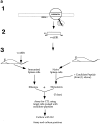Murine cytotoxic T lymphocytes recognize an epitope in an EBNA-1 fragment, but fail to lyse EBNA-1-expressing mouse cells
- PMID: 9449725
- PMCID: PMC2212114
- DOI: 10.1084/jem.187.3.445
Murine cytotoxic T lymphocytes recognize an epitope in an EBNA-1 fragment, but fail to lyse EBNA-1-expressing mouse cells
Abstract
Major histocompatibility complex class I-restricted cytotoxic T lymphocytes (CTLs) specific for epitopes within eight of the nine Epstein Barr Virus (EBV)-encoded latency-associated proteins have been recovered from EBV-infected human subjects by restimulation of lymphocytes in vitro. However, human class I-restricted CTL responses capable of recognizing EBNA-1 expressing cells were not detected in these studies. We have raised a murine CTL line that recognizes an epitope within EBNA-1 by immunizing mice with a vaccinia virus encoding a COOH-terminal EBNA-1 fragment. This novel CTL line was used to investigate whether the epitope (positions 509-517 in EBNA-1, presented through Kd) was presented to CTL by mouse cells expressing full-length EBNA-1 or a deletion mutant of EBNA-1, lacking the Glycine-Alanine (Gly-Ala)-rich region. Cells expressing full-length EBNA-1 are not lysed by the CTL line, whereas cells expressing the Gly-Ala deletion mutant are recognized. These results suggest that epitopes from full-length EBNA-1 are poorly presented, and that the Gly-Ala-rich region is responsible for this phenomenon. The inefficient presentation of EBNA-1-derived epitopes may explain the absence or rarity of EBNA-1-specific CTLs in vivo, a strategy that may allow EBV to maintain persistence within the immunocompetent host without being eliminated by CTLs.
Figures








Similar articles
-
Localization of Epstein-Barr virus cytotoxic T cell epitopes using recombinant vaccinia: implications for vaccine development.J Exp Med. 1992 Jul 1;176(1):169-76. doi: 10.1084/jem.176.1.169. J Exp Med. 1992. PMID: 1377222 Free PMC article.
-
Class I major histocompatibility complex-restricted cytotoxic T lymphocytes specific for Epstein-Barr virus (EBV)-transformed B lymphoblastoid cell lines against which they were raised.J Exp Med. 1995 Jun 1;181(6):2221-8. doi: 10.1084/jem.181.6.2221. J Exp Med. 1995. PMID: 7539044 Free PMC article.
-
Isolation of cytotoxic T lymphocytes from healthy seropositive individuals specific for peptide epitopes from Epstein-Barr virus nuclear antigen 1: implications for viral persistence and tumor surveillance.Virology. 1995 Dec 20;214(2):633-7. doi: 10.1006/viro.1995.0076. Virology. 1995. PMID: 8553567
-
T cell recognition of Epstein-Barr virus associated lymphomas.Cancer Surv. 1992;13:53-80. Cancer Surv. 1992. PMID: 1330300 Review.
-
HIV epitopes recognized by cytotoxic T-lymphocytes.AIDS. 1991;5 Suppl 2:S145-50. doi: 10.1097/00002030-199101001-00020. AIDS. 1991. PMID: 1726954 Review. No abstract available.
Cited by
-
Endogenous presentation of CD8+ T cell epitopes from Epstein-Barr virus-encoded nuclear antigen 1.J Exp Med. 2004 May 17;199(10):1421-31. doi: 10.1084/jem.20040191. J Exp Med. 2004. PMID: 15148340 Free PMC article.
-
Inhibition of antigen presentation by the glycine/alanine repeat domain is not conserved in simian homologues of Epstein-Barr virus nuclear antigen 1.J Virol. 1999 Sep;73(9):7381-9. doi: 10.1128/JVI.73.9.7381-7389.1999. J Virol. 1999. PMID: 10438828 Free PMC article.
-
Gamma-herpesvirus latency requires T cell evasion during episome maintenance.PLoS Biol. 2005 Apr;3(4):e120. doi: 10.1371/journal.pbio.0030120. Epub 2005 Mar 22. PLoS Biol. 2005. PMID: 15769185 Free PMC article.
-
G-quadruplexes regulate Epstein-Barr virus-encoded nuclear antigen 1 mRNA translation.Nat Chem Biol. 2014 May;10(5):358-64. doi: 10.1038/nchembio.1479. Epub 2014 Mar 16. Nat Chem Biol. 2014. PMID: 24633353 Free PMC article.
-
Critical role of EBNA1-specific CD4+ T cells in the control of mouse Burkitt lymphoma in vivo.J Clin Invest. 2004 Aug;114(4):542-50. doi: 10.1172/JCI22053. J Clin Invest. 2004. PMID: 15314691 Free PMC article.
References
-
- Kieff, E. 1996. Epstein Barr virus and its replication. In Virology. B.N. Fields, D.M. Knipe, P. Howley, R. Chanock, J. Melnick, T. Monath, B. Rozman, S.E. Straus, editors. Lippincott-Raven Press, New York. 2243–2396.
-
- Klein G. Viral latency and transformation: the strategy of Epstein Barr virus. Cell. 1989;58:5–8. - PubMed
-
- Townsend A, Bodmer H. Antigen recognition by class I–restricted T lymphocytes. Annu Rev Immunol. 1989;7:601–624. - PubMed
Publication types
MeSH terms
Substances
LinkOut - more resources
Full Text Sources
Other Literature Sources
Molecular Biology Databases

